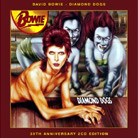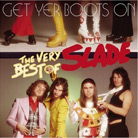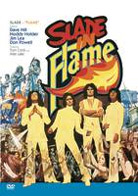June 2004
 By the time David Bowie broke through in the US in 1972 with The Rise and
Fall of Ziggy Stardust and the Spiders from Mars, he had already tried on and
discarded several personae. Pointing to the many transformations Bowie has gone through
since then should help dispatch any charges of cynicism or calculation on his part,
especially since his changes in appearance have often coincided with significant,
sometimes brave changes in his music. Bowie’s image in the early '70s -- androgynous,
flamboyant, overtly pansexual -- defined the time perfectly, and he aided a host of
artists who, while not strictly imitators, followed his lead. He produced Mott the Hoople,
Lou Reed, and Iggy Pop (the latter two were prime influences) and at the same time gave
them a glam-rock style that was bracing in an era of t-shirts and jeans. By the time David Bowie broke through in the US in 1972 with The Rise and
Fall of Ziggy Stardust and the Spiders from Mars, he had already tried on and
discarded several personae. Pointing to the many transformations Bowie has gone through
since then should help dispatch any charges of cynicism or calculation on his part,
especially since his changes in appearance have often coincided with significant,
sometimes brave changes in his music. Bowie’s image in the early '70s -- androgynous,
flamboyant, overtly pansexual -- defined the time perfectly, and he aided a host of
artists who, while not strictly imitators, followed his lead. He produced Mott the Hoople,
Lou Reed, and Iggy Pop (the latter two were prime influences) and at the same time gave
them a glam-rock style that was bracing in an era of t-shirts and jeans.
In 1974,Bowie rid himself of the Ziggy alter ego (though he kept the haircut for a few months) and dropped the band that had, with minor personnel changes, backed him on three recordings. After two albums of straightahead rock, he was ready for something new and began a musical based on George Orwell’s novel 1984. Orwell’s widow refused to grant him rights to the book ("She said she’s seen one film of it, and that that was such a disaster that she’ll never let it out of her grasp ever again."). Bowie took some of the novels’s themes and combined them with other dystopic views, including those of novelist William Burroughs, to create Diamond Dogs. Diamond Dogs was Bowie’s eighth album and it showed a pronounced musical-theater influence that his previous recordings had already hinted at. It also contained a strong hint of disco and soul, which Bowie would pursue more fully on Young Americans. That an album containing those musical strains could also include one of the signature guitar anthems of the '70s, "Rebel Rebel," says something about how wide Bowie cast his net here. On "Sweet Thing" and "We are the Dead" he sounds like a hip Anthony Newley. For "1984" he cops the intro to Isaac Hayes’s "Shaft" and successfully merges it with the grand theatrical gestures of the song. Rock, musical theater, and soul coexist peacefully throughout the disc, sometimes in the same song. Diamond Dogs benefits from very intelligent song sequencing, and its cumulative effect is powerful. That doesn’t mean its concept ever really gels. As with most rock concept albums, there’s no narrative to hold things together. Bowie takes some impressions from 1984 and from some of Burroughs’s books (especially The Wild Boys) and creates an atmosphere of dread, but in "Sweet Thing" and "We Are the Dead" he could as easily be describing the nihilism of the '70s as any future horror. In 1974, David Bowie seemed to be seeing hints of the future, and Diamond Dogs suggests he wasn’t sure he liked what he saw. This new, 30th anniversary reissue is packaged in a manner similar to the Ziggy and Alladin Sane anniversary releases. It includes a 40-page booklet that explains some of the concepts behind Diamond Dogs and describes how it was recorded. The disc sleeves and booklet are bound into a CD-case-sized hardcover booklet. The remastering for Diamond Dogs was done by Peter Mew with Nigel Reeve at Abbey Road, and it’s a little warmer and flows a little more easily than previous masters. In other words, it shows the advantages of 24-bit technology. I’ve always felt that the Rykodisc remasters of Bowie’s catalog were excellent, but this Diamond Dogs has a little more analog warmth. The anniversary version includes a bonus disc comprising eight tracks from the same time period, of which the most interesting is a slightly camp version of Bruce Springsteen’s "Growin’ Up." At first glance, Slade would seem to have little in common with Bowie. They were four working-class Brits who rarely ventured beyond three-chord rock'n'roll. Yet they were a glam-rock phenomenon whose platform shoes, outrageous costumes, and strange haircuts (especially guitarist Dave Hill’s) were as much a part of '70s British rock as Bowie or his counterparts. Slade was discovered and produced by Chas Chandler, the ex-bassist for the Animals who had brought Jimi Hendrix to England and produced his first two records. Slade’s track record in England was impressive -- 17 top 20 hits -- but the closest they came to a hit in the US was a #68 in 1972 with "Gudbuy T’ Jane." Eleven years later Quiet Riot, an American band, reached number 5 in the US with Slade’s "Cum On Feel the Noize." Slade’s version is just as loud, just as rude, and infinitely better. For me, the quintessential Slade moment occurred during a live version of John Sebastian’s "Darling Be Home Soon" from Slade Alive. The opening verses of the song are performed in an uncharacteristically gentle way before the song carries on in typical Slade-mayhem fashion. At one point during the quieter portion, singer Noddy Holder leans into the mike for a belch that must have shattered every windshield in the arena parking lot. A punk moment, if there ever was one. That track isn’t included in Get Yer Boots On, but it does contain 16 other examples of Slade’s very basic, high-energy rock. Punk bands often pointed to the influence of the Ramones or the New York Dolls, but I think that in an era of progressive rock, jam bands, and glam, British kids must have taken these guys as an inspiration for what was still possible for four or five kids playing music in a garage. Get Yer Boots On is the first Slade compilation to be released in the US and any rock completist should own it.
Americans will find some of the film’s details, such as the enclosed sidecar that brings drummer Charlie (Don Powell) home from a gig, to be very English and exotic. US rock fans will also want to catch the section of the movie that takes place at a pirate radio station, which will help them understand what the Clash were singing about in "Capital Radio." The story of Flame isn't a glamorous tale of sex, drugs, and rock'n'roll. The band is exploited and shortchanged at every turn - - by their original singer, by their manager, and by the advertising executive who decides that pop music can be marketed like any other commodity. The DVD transfer is, inexplicably, not a full letterbox and the sound is mono. Those two things don’t detract from the impact of the story. Slade's acting abilities vary (although singer Noddy Holder as Stoker is very good), but Flame rings true. A lengthy, very entertaining interview with Holder is added to the DVD and he confirms that many of the film’s incidents are based on fact. If you’ve ever wanted to be a rock star, watch Flame and be thankful your wish didn’t come true. GO BACK TO: |
 David Bowie - Diamond
Dogs (30th Anniversary Edition)
David Bowie - Diamond
Dogs (30th Anniversary Edition) Slade - Get Yer Boots On: The Best of Slade
Slade - Get Yer Boots On: The Best of Slade Slade in Flame
Slade in Flame Slade was so popular in the UK and the rest
of Europe that Chas Chandler got the green light to make a feature film with them. Slade
portrayed a rock band named Flame and the movie tells the story of their rise to fame.
Fans were expecting an amusing romp, something like the Beatles’ A Hard Days
Nightł but Chandler and the band had something else in mind. Flame was a
realistic look at the life of a rock band. It was also a grim portrait of working-class
England in the mid-'70s. After a few scenes of boarded-up row houses and bland modern
high-rises filled with cramped apartments, you begin to understand the frustration that
drove bands like the Sex Pistols and the Clash.
Slade was so popular in the UK and the rest
of Europe that Chas Chandler got the green light to make a feature film with them. Slade
portrayed a rock band named Flame and the movie tells the story of their rise to fame.
Fans were expecting an amusing romp, something like the Beatles’ A Hard Days
Nightł but Chandler and the band had something else in mind. Flame was a
realistic look at the life of a rock band. It was also a grim portrait of working-class
England in the mid-'70s. After a few scenes of boarded-up row houses and bland modern
high-rises filled with cramped apartments, you begin to understand the frustration that
drove bands like the Sex Pistols and the Clash.